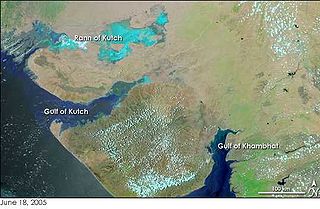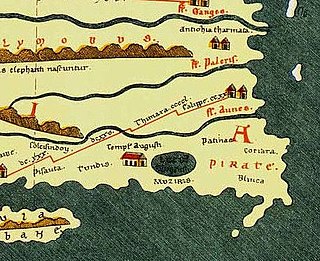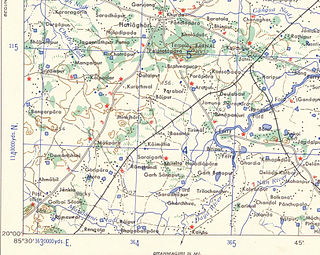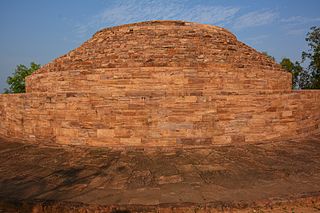Related Research Articles

Chilika Lake is the largest brackish water lagoon in Asia and second largest coastal lagoon in the world, covering an area of over 1,100 square kilometres (420 sq mi). It is spread over the Puri, Khordha and Ganjam districts of Odisha state on the east coast of India, at the mouth of the Daya River, flowing into the Bay of Bengal.
Gopalpur is a coastal town and a Notified Area Council on the Bay of Bengal coast in Ganjam district in the southern part of Odisha, India. Today it is a commercial port, a famous sea beach and a tourist destination. Gopalpur is around 15 km from Berhampur. The reconstruction of an all weather port including new berths is under development.

Konark is a medium town in the Puri district in the state of Odisha, India. It lies on the coast by the Bay of Bengal, 65 kilometres from the capital of the state, Bhubaneswar. It is the site of the 13th-century Sun Temple, also known as the Black Pagoda, built in black granite during the reign of Narasinghadeva-I. The temple is a World Heritage Site. The temple is now mostly in ruins, and a collection of its sculptures is housed in the Sun Temple Museum, which is run by the Archaeological Survey of India.

Indian maritime history begins during the 3rd millennium BCE when inhabitants of the Indus Valley initiated maritime trading contact with Mesopotamia. India's long coastline, which occurred due to the protrusion of India's Deccan Plateau, helped it to make new trade relations with the Europeans, especially the Greeks, and the length of its coastline on the Indian Ocean is partly a reason why it's known as that.

Arikamedu is an archaeological site in Southern India, in Kakkayanthope, Ariyankuppam Commune, Puducherry. It is 4 kilometres (2.5 mi) from the capital, Pondicherry of the Indian territory of Puducherry.

Muchiri, commonly anglicized as Muziris was an ancient harbour and an urban centre on the Malabar Coast. Muziris found mention in the Periplus of the Erythraean Sea, the bardic Tamil poems and a number of classical sources. It was the major ancient port city of Cheras. The exact location of Muziris has been a matter of dispute among historians and archaeologists. However, excavations since 2004 at Pattanam in Ernakulam district of Kerala have led some experts to suggesting the hypothesis that the city was located just there. It was an important trading port for Christian and Muslim merchants arriving from other countries.

Puri district is a coastal district of the Odisha state of India. It has one sub-division, 11 tahasils and 11 blocks and comprises 1722 revenue villages. Puri is the only municipality of the district. Konark, Pipili, Satyabadi, Gop, Kakatpur and Nimapada are the NACs in this district while Brahmagiri being a semi-urban town.

Tamralipta or Tamralipti was an ancient port city and capital of Suhma kingdom in ancient India, located on the coast of the Bay of Bengal. The Tamluk town in present-day Purba Medinipur, West Bengal, is generally identified as the site of Tamralipti.

Konark Sun Temple is a 13th-century CE Hindu Sun temple at Konark about 35 kilometres (22 mi) northeast from Puri city on the coastline in Puri district, Odisha, India. The temple is attributed to king Narasingha Deva I of the Eastern Ganga dynasty about 1250 CE.

Pushpagiri was an ancient Indian mahavihara or monastic complex located atop Langudi Hill in Jajpur district of Odisha, India. Pushpagiri was mentioned in the writings of the Chinese traveller Xuanzang and some other ancient sources. Until the 1990s, it was hypothesised to be one or all of the Lalitgiri-Ratnagiri-Udayagiri group of monastic sites, also located in Jajpur district. These sites contain ruins of many buildings, stupas of various sizes, sculptures, and other artifacts.

Boitas were larger boats and ships that were built in the ancient Kalinga region during its maritime history. Kalinga's sea facing regions consisting of coastal Odisha had major trading ports for which boitas were used. Ancient Sadhabas sailed from Kalinga to distant lands such of Sri Lanka and South-East Asia including both mainland and insular Southeast Asian regions for trade.
Sadhabas were ancient mariners from the Kalinga region, which roughly corresponds to modern Odisha, India. They used ships called Boitas to travel to distant lands such as South-East Asia to carry out trade.

Golabai Sasan is a village in Khurda District, Odisha, India at 20°1′21″N85°33′0″E.

Lalitagiri is a major Buddhist complex in the Indian state of Odisha. The complex is home to stupas, 'esoteric' Buddha images, and monasteries (viharas), which is the oldest site in the region. Significant finds at this complex include Buddha's relics. Tantric Buddhism was practiced at this site.

The Maritime history of Odisha, known as Kalinga in ancient times, started much before 800 BC according to early sources. The people of this region of eastern India along the coast of the Bay of Bengal sailed up and down the Indian coast, and travelled to Indo China and throughout Maritime Southeast Asia, introducing elements of their culture to the people with whom they traded. The 6th century Manjusrimulakalpa mentions the Bay of Bengal as Kalingodra and in ancient Classical India, the Bay of Bengal was known as Kalinga Sagar, indicating the importance of Kalinga in the maritime trade. The old traditions are still celebrated in the annual Boita Bandana festival including its major celebration at Cuttack on the banks of Mahanadi river called Bali Jatra, and are held for seven days in October-November at various coastal districts, most famous at Cuttack though.
Chelitalo was an important port in Ancient Odisha, in northeast India, lying on the Chandrabhaga river in Konark. In ancient times, the Chandrabhaga and Kushabhadra rivers were navigable, and may have been used for the shipping of huge blocks of stone for the construction of the Konark Sun Temple.
Manikpatna or Manikapatna is an archeological site in the state of Odisha in eastern India. It has been identified with the medieval port of Chelitalo described by the Chinese pilgrim Hiuen Tsang. The site is located on the sea coast near Brahmagiri which is situated near the left bank of the Bhargavi river, at the northeastern end of the Chilika Lake.
Pithunda was a port in the ancient kingdom of Kalinga on the eastern coast of India. Pithunda, or Prithuda was the capital of an old kingdom. The region was situated adjacent to another kingdom, which is located in Bandar taluk, now the modern Krishna district of Andhra Pradesh, not far from Masulipatam. Sylvain Levi considers that Pithunda was located to the south of Palur near Chicacola and Kalingapatanam.

Kaundinya I, also known as Hùntián, Hỗn Điền and Preah Thong, was the second monarch of Funan which comprises much of Cambodia located in mainland Southeast Asia centered on the Mekong Delta. He was the consort of the first monarch Soma, Queen of Funan, also known as Liǔyè (Chinese) and Neang Neakii (Khmer) and together both were the co-founders of the kingdom of Funan with the capital located at Vyadhapura.
The Murunda dynasty ruled in the Utkal region of modern Odisha in eastern India during 2nd and 3rd centuries CE. Their territory included parts of the area around the northern districts of coastal Odisha. They appear to have succeeded the Mahameghavahana dynasty and then replaced by Nagas of Vindhyatabi and the Gupta Empire.
References
- 1 2 Tripathi, Sila (25 July 2015), "Khalkattapatna port: the lost archaeological heritage of Odisha, east coast of India", Current Science, 109 (2), Current Science Association: 372–377, JSTOR 24905868
- 1 2 Sila Tripati. "Management of Ports and Maritime Trade of Orissa and Andhra Pradesh during the Historical Period" (PDF). Man Environ., vol.34(2); 2009; 77–90. Retrieved 25 November 2010.
- ↑ D.P. Agrawal and Lalit Tiwari. "Review: Maritime Heritage of India. K.S. Behera (Ed.) 1999". Infinity Foundation. Retrieved 25 November 2010.
- ↑ "Excavations – Since Independence – Orissa". Archaeological Survey of India. Archived from the original on 1 November 2010. Retrieved 25 November 2010.
- ↑ Patra, Benudhar (2013), "Ports and Port Towns of Early Odisha: Text, Archaeology and Identification", Proceedings of the Indian History Congress, 74, Indian History Congress: 55–56, JSTOR 44158798
- ↑ DR. BENUDHAR PATRA. "Antiquity of Arkakshetra Konark". Sampradaya Sun. Retrieved 25 November 2010.